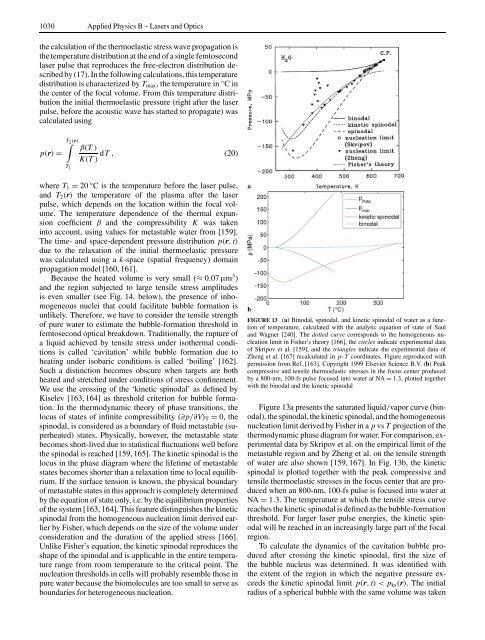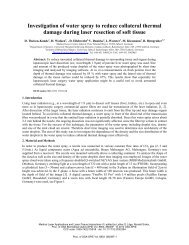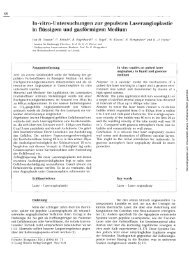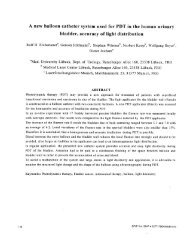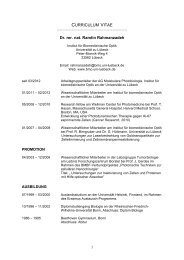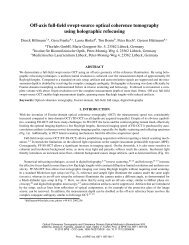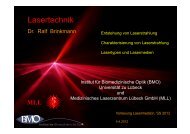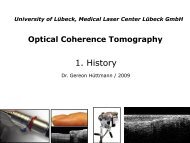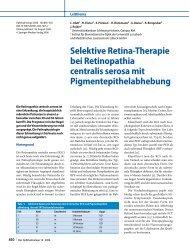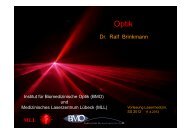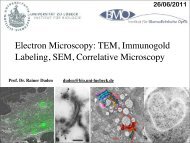Invited p aper Mechanisms of femtosecond laser nanosurgery of ...
Invited p aper Mechanisms of femtosecond laser nanosurgery of ...
Invited p aper Mechanisms of femtosecond laser nanosurgery of ...
You also want an ePaper? Increase the reach of your titles
YUMPU automatically turns print PDFs into web optimized ePapers that Google loves.
1030 Applied Physics B – Lasers and Opticsthe calculation <strong>of</strong> the thermoelastic stress wave propagation isthe temperature distribution at the end <strong>of</strong> a single <strong>femtosecond</strong><strong>laser</strong> pulse that reproduces the free-electron distribution describedby (17). In the following calculations, this temperaturedistribution is characterized by T max , the temperature in ◦ C inthe center <strong>of</strong> the focal volume. From this temperature distributionthe initial thermoelastic pressure (right after the <strong>laser</strong>pulse, before the acoustic wave has started to propagate) wascalculated usingp(r) =T∫2 (r)β(T )K(T )T 1dT , (20)where T 1 = 20 ◦ C is the temperature before the <strong>laser</strong> pulse,and T 2 (r) the temperature <strong>of</strong> the plasma after the <strong>laser</strong>pulse, which depends on the location within the focal volume.The temperature dependence <strong>of</strong> the thermal expansioncoefficient β and the compressibility K was takeninto account, using values for metastable water from [159].The time- and space-dependent pressure distribution p(r, t)due to the relaxation <strong>of</strong> the initial thermoelastic pressurewas calculated using a k-space (spatial frequency) domainpropagation model [160, 161].Because the heated volume is very small (≈ 0.07 µm 3 )and the region subjected to large tensile stress amplitudesis even smaller (see Fig. 14, below), the presence <strong>of</strong> inhomogeneousnuclei that could facilitate bubble formation isunlikely. Therefore, we have to consider the tensile strength<strong>of</strong> pure water to estimate the bubble-formation threshold in<strong>femtosecond</strong> optical breakdown. Traditionally, the rupture <strong>of</strong>a liquid achieved by tensile stress under isothermal conditionsis called ‘cavitation’ while bubble formation due toheating under isobaric conditions is called ‘boiling’ [162].Such a distinction becomes obscure when targets are bothheated and stretched under conditions <strong>of</strong> stress confinement.We use the crossing <strong>of</strong> the ‘kinetic spinodal’ as defined byKiselev [163, 164] as threshold criterion for bubble formation.In the thermodynamic theory <strong>of</strong> phase transitions, thelocus <strong>of</strong> states <strong>of</strong> infinite compressibility (∂p/∂V) T = 0, thespinodal, is considered as a boundary <strong>of</strong> fluid metastable (superheated)states. Physically, however, the metastable statebecomes short-lived due to statistical fluctuations well beforethe spinodal is reached [159, 165]. The kinetic spinodal is thelocus in the phase diagram where the lifetime <strong>of</strong> metastablestates becomes shorter than a relaxation time to local equilibrium.If the surface tension is known, the physical boundary<strong>of</strong> metastable states in this approach is completely determinedby the equation <strong>of</strong> state only, i.e. by the equilibrium properties<strong>of</strong> the system [163, 164]. This feature distinguishes the kineticspinodal from the homogeneous nucleation limit derived earlierby Fisher, which depends on the size <strong>of</strong> the volume underconsideration and the duration <strong>of</strong> the applied stress [166].Unlike Fisher’s equation, the kinetic spinodal reproduces theshape <strong>of</strong> the spinodal and is applicable in the entire temperaturerange from room temperature to the critical point. Thenucleation thresholds in cells will probably resemble those inpure water because the biomolecules are too small to serve asboundaries for heterogeneous nucleation.FIGURE 13 (a) Binodal, spinodal, and kinetic spinodal <strong>of</strong> water as a function<strong>of</strong> temperature, calculated with the analytic equation <strong>of</strong> state <strong>of</strong> Sauland Wagner [240]. The dotted curve corresponds to the homogeneous nucleationlimit in Fisher’s theory [166], the circles indicate experimental data<strong>of</strong> Skripov et al. [159], and the triangles indicate the experimental data <strong>of</strong>Zheng et al. [167] recalculated in p–T coordinates. Figure reproduced withpermission from Ref. [163]. Copyright 1999 Elsevier Science B.V. (b) Peakcompressive and tensile thermoelastic stresses in the focus center producedby a 800-nm, 100-fs pulse focused into water at NA = 1.3, plotted togetherwith the binodal and the kinetic spinodalFigure 13a presents the saturated liquid/vapor curve (binodal),the spinodal, the kinetic spinodal, and the homogeneousnucleation limit derived by Fisher in a p vs T projection <strong>of</strong> thethermodynamic phase diagram for water. For comparison, experimentaldata by Skripov et al. on the empirical limit <strong>of</strong> themetastable region and by Zheng et al. on the tensile strength<strong>of</strong> water are also shown [159, 167]. In Fig. 13b, the kineticspinodal is plotted together with the peak compressive andtensile thermoelastic stresses in the focus center that are producedwhen an 800-nm, 100-fs pulse is focused into water atNA = 1.3. The temperature at which the tensile stress curvereaches the kinetic spinodal is defined as the bubble-formationthreshold. For larger <strong>laser</strong> pulse energies, the kinetic spinodalwill be reached in an increasingly large part <strong>of</strong> the focalregion.To calculate the dynamics <strong>of</strong> the cavitation bubble producedafter crossing the kinetic spinodal, first the size <strong>of</strong>the bubble nucleus was determined. It was identified withthe extent <strong>of</strong> the region in which the negative pressure exceedsthe kinetic spinodal limit p(r, t)


